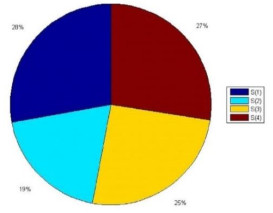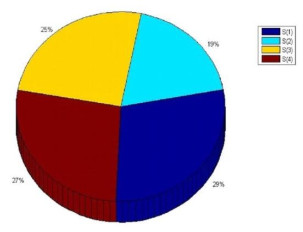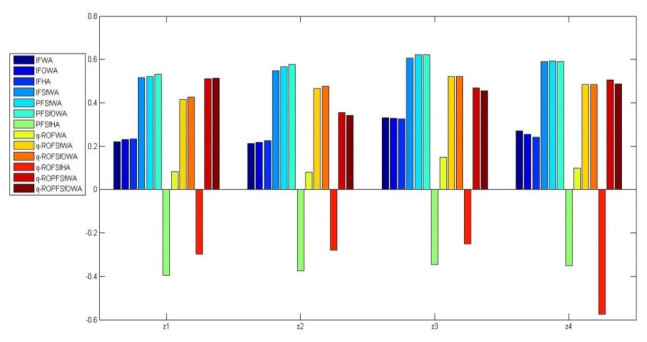1.
Introduction
Differential equations of arbitrary order have been shown to be useful in the study of models of many phenomena in various fields such as: Electrochemistry and material science, they are in fact described by differential equations of fractional order [9,10,15,16,25,26,27,28,29]. For more details, we refer the reader to the books of Hilfer [30], Podlubny [31], Kilbas et al. [34], Miller and Ross [2] and to the following research papers [1,2,3,4,5,6,7,8,11,12,14,16,17,19,20,24,31,35,36,37,38,39,40,41,42]. In this work, we discuss the existence and uniqueness of the solutions for multi-point boundary value problems of nonlinear fractional differential equations with two Riemann-Liouville fractionals:
where D(.), I(.) denote the Riemann-Liouville derivative and integral of fractional order (.), respectively, fi, gi:[0,T]×R4→R, i=1,⋯,m are continuous functions on [0,T] and
with Ai and Bi being continuous functions on [0,1]×[0,1]. However, it is rare to find a work in nonlinear term fi depends on fractional derivative of unknown functions x(t),y(t),φ1x(t),ϕ1y(t) and solutions for multi-order fractional differential equations on the infinite interval [0,T). Motivated by [8,11,12,13,14] and the references therein, we consider the existence and unicity of solution for multi-order fractional differential equations on infinite interval [0,T).
The rest of this paper is organized as follow. In section 2, we present some preliminaries and lemmas. Section 3 is dedicated to showing the existence of a solution for problem (1.1). Finally, section 4 illustrated the proposed results with two examples.
Remark 1.1. This work generalizes the work of Houas and Benbachir [14] on different boundary conditions and for another type of integral.
2.
Preliminaries
This section covers the basic concepts of Riemann-Liouville type fractional calculus that will be used throughout this paper.
Definition 2.1. [31,32] The Riemann-Liouville fractional integral operator of order α≥0, of a function f:(0,∞)→R is defined as
where Γ(α):=∫∞0e−uuα−1du.
Definition 2.2. [31,32] The Riemann-Liouville fractional derivative of order α>0, of a continuous function h:(0,∞)→R is defined as
where n=[α]+1.
For α<0, we use the convention that Dαh=J−αh. Also for 0≤ρ<α, it is valid that DρJαh=hα−ρ. We note that for ε>−1 and ε≠α−1,α−2,...,α−n, we have
In particular, for the constant function h(t)=1, we obtain
For α∈N, we obtain, of course, Dα1=0 because of the poles of the gamma function at the points 0,−1,−2,... For α>0, the general solution of the homgeneous equation Dαh(t)=0 in C(0,T)∩L(0,T) is
where ci,i=1,2,....,n−1, are arbitrary real constants. Further, we always have DαIαh=h, and
Lemma 2.1. [33] Let E be Banach space. Assume that T:E⟶E is a completely continuous operator. If the set V={x∈E:x=μTx, 0<μ<1} is bounded, then T has a fixed point in E.
To define the solution for problem (1.1). We consider the following lemma.
Lemma 2.2. Suppose that (Hi)i=1,…,m⊂C([0,1],R), and consider the problem
with the conditions
Then we have
with ψ=θΓ(α)Γ(2α−1)η2α−2−Γ(α)T.
Proof. We have
where ci∈R, i=0,1.
We obtain
Using the given conditions: I2−αh(0)=0, we find that c0=0, and since Dα−2h(T)−θIα−1(h(η))=0, we have
then
and
with
Finally, the solution of (2.1) and (2.2) is
3.
Main results
We denote by
and the Banach space of all continuous functions from [0,T] to R endowed with a topology of uniform convergence with the norm defined by
where
In this section, we prove some existence and uniqueness results to the nonlinear fractional coupled system (1.1).
For the sake of convenience, we impose the following hypotheses:
(H1) For each i=1,2,⋯,m, the functions fi and gi :[0,T]×R4⟶R are continuous.
(H2) There exist nonnegative real numbers ξik,φik,k=1,2,3,4,i=1,2,⋯,m, such that for all t∈[0,T] and all (x1,x2,x3,x4), (y1,y2,y3,y4)∈R4, we have
and
(H3) There exist nonnegative constants (Li) and (Ki) i=1,...,m, such that: For each t∈[0,T] and all (x1,x2,x3,x4)∈R4,
We also consider the following quantities:
3.1. Existence of solutions
The first result is based on Banach contraction principle. We have
Theorem 3.1. Assume that (H2) holds. If the inequality
is valid, then the system (1.1) has a unique solution on [0,T].
Proof. We define the operator T:E⟶E by
such that
and
where
and
We obtain
where i=1,2.
We shall now prove that T is contractive.
Let T1(x1,y1),T2(x2,y2)∈E. Then, for each t∈[0,T], we have
By (H2), it follows that
Hence,
With the same arguments as before, we can show that
On the other hand, we have
Hence,
and
Also, we have
and
Thanks to (3.4)–(3.9), we get
Thanks to (3.10), we conclude that T is a contractive operator. Therefore, by Banach fixed point theorem, T has a unique fixed point which is the solution of the system (1.1).
3.2. Uniqueness of solutions
Our second main result is based on Lemma 2.1. We have
Theorem 3.2. Assume that the hypotheses (H1) and (H3) are satisfied. Then, system (1.1) has at least a solution on [0,T].
Proof. The operator T is continuous on E in view of the continuity of fi and gi (hypothesis (H1)).
Now, we show that T is completely continuous:
(i) First, we prove that T maps bounded sets of E into bounded sets of E. Taking λ>0, and (x,y)∈Ωλ={(x,y)∈E;||(x,y)||≤λ}, then for each t∈[0,T], we have:
Thanks to (H3), we can write
Thus,
As before, we have
On the other hand, for all j=1,2, we get
This implies that
Similarly, we have
It follows from (3.11)–(3.16) that:
Thus,
(ii) Second, we prove that T is equi-continuous:
For any 0≤t1<t2≤T and (x,y)∈Ωλ, we have
Therefore,
We also have
On the other hand,
Consequently, for all i=1,2, we obtain
Similarly,
where i=1,2. Using (3.17)–(3.20), we deduce that
as t2→t1.
Combining (i) and (ii), we conclude that T is completely continuous.
(iii) Finally, we shall prove that the set F defined by
is bounded.
Let (x,y)∈F, then (x,y)=ρT(x,y), for some 0<ρ<1. Thus, for each t∈[0,T], we have:
Thanks to (H3) and using (3.11) and (3.12), we deduce that
Using (3.13)–(3.16), it yields that
It follows from (3.22) and (3.23) that
Consequently,
This shows that F is bounded. By Lemma (2.1), we deduce that T has a fixed point, which is a solution of (1.1).
4.
Related examples
To illustrate our main results, we treat the following examples.
Example 4.1. Consider the following system:
We have
Also,
For t∈[0,1] and (x1,y1,φ1x1,ϕ1y1),(x2,y2,φ1x2,ϕ1y2)∈R4, we have
and
So, we can take
We also have
and
For t∈[0,1] and (x1,y1,φ2x1,ϕ2y1),(x2,y2,φ2x2,ϕ2y2)∈R4, we can write
and
Hence,
Therefore,
Suppose
so,
Thus,
and by Theorem 3.1, we conclude that the system (4.1) has a unique solution on [0,1].
Example 4.2.
We have
Since
The functions f1, f2, g1 and g2 are continuous and bounded on [0,1]×R4. So, by Theorem 3.2, the system (4.10) has at least one solution on [0,1].
5.
Conclusions
We have proved the existence of solutions for fractional differential equations with integral and multi-point boundary conditions. The problem is solved by applying some fixed point theorems. We also provide examples to make our results clear.
Conflict of interest
The authors declare that they have no conflicts of interest in this paper.
















 DownLoad:
DownLoad: